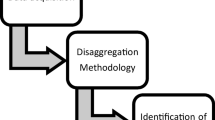Abstract
In induction home appliances, recipient size estimation is very important for the adjustment of the power that the hob must supply to the cooking recipient. Conventional techniques first calculate a simple R–L equivalent circuit from voltage and current waveforms in the heating inductor and then estimate physical parameters (such as recipient size) by regression. In this paper, a new technique is proposed for recipient size estimation, based on spectral analysis and artificial neural networks (ANN), which, for two reasons, is more accurate than current procedures: (i) The new technique performs a direct estimation of recipient size from voltage and current, without needing to compute an intermediate electrical equivalent circuit (which in fact only represents a rough approximation), and (ii) due to their nonlinear modeling capabilities, ANNs are more appropriate than regression for this problem. By using a database of cooking recipients, our procedure provides an accuracy of 85–90 %, outperforming the 58 % of conventional techniques (70 % including an additional sensor). The new technique has been implemented and verified by using a commercial embedded processor, similar to those included in current domestic induction home appliances. It could be built in by manufacturers at no extra cost as it requires no additional sensors and makes use of computational resources integrated into the microcontroller or the digital signal processor that controls the home appliance.










Similar content being viewed by others
References
Abu-Mostafa YS, Malik MI, Hsuan-Tien L (2012) Learning from data. AMLBook, Florida
Acero J, Burdio JM, Barragan LA, Navarro D, Alonso R, Ramon J, Monterde F, Hernandez P, Llorente S, Garde I (2010) Domestic induction appliances. IEEE Ind Appl Mag 16(2):39–47
Bernal C, Martín-del-Brío B, Bono A, García F (2005) Speech recognition with low cost microcontrollers. IADAT J Adv Technol Autom Control Instrum 1(2):72–74
Brennan PV, Huang Y, Ash M, Chetty K (2011) Determination of sweep linearity requirements in FMCW radar systems based on simple voltage-controlled oscillator sources. IEEE Trans Aerosp Electron Syst 47(3):1594–1604
Carretero C, Lucia O, Acero J, Burdio J M (2012) First harmonic equivalent impedance of coupled inductive loads for induction heating applications. In: IECON 2012—38th Annual Conference on IEEE Industrial Electronics Society, pp 427–432, 25–28
Duda RO, Hart PE, Stork DG (2001) Pattern classification. Wiley, New York
Haykin SO (2009) Neural networks and learning machines. Prentice Hall, Upper Saddle River
Jiménez O, Barragán LA, Navarro D, Lucia O, Artigas JI, Urriza I (2010) FPGA-based real-time calculation of the harmonic impedance of series resonant inductive loads. In: IECON 2010—36th Annual Conference on IEEE Industrial Electronics Society, pp 1715–1720, 7–10 Nov 2010
Kohavi R (1995) A study of cross-validation and bootstrap for accuracy estimation and model selection. In: Proceedings of the Fourteenth International Joint Conference on Artificial Intelligence (San Mateo, CA: Morgan Kaufmann), vol 2, No. 12, pp 1137–1143
Laso MAG, Lopetegi T, Erro MJ, Benito D, Garde MJ, Muriel MA, Sorolla M, Guglielmi M (2003) Real-time spectrum analysis in microstrip technology. IEEE Trans Microw Theory Tech 51(3):705–717
Marsland S (2009) Machine learning: an algorithmic introduction. CRC Press, Boca Raton
Martín-del-Brío B, Medrano N, Bono A (2005) Intelligent sensors based on neural networks programmed onto standard microcontrollers. IADAT J Adv Technol Autom Control Instrum 1(2):63–65
MATLAB Documentation. www.mathworks.com/help/matlab/
Medrano N, Martín-del-Brío B (2001) Sensor linearization with neural networks. IEEE Trans Ind Electron 48(6):1288–1290
Molina P, Bernal C, Otin A, Burdio JM (2011) Silicon carbide JFET resonant inverter for induction heating home appliances. In: IECON2011 37th Annual Conference on IEEE Industrial Electronics Society, 7–10, pp 2551–2556
Oppenheim AV, Schafer RW (1989) Discrete-time signal processing. Prentice Hall, Upper Saddle River
Pauwels HJ (1967) First-harmonic approximation in nonlinear filtered circuits. In: Proceedings of the IEEE, vol 55, No. 10, pp 1744–1745
Puyal D, Bernal C, Burdio JM, Acero J, Millan I (2007) Methods and procedures for accurate induction heating load measurement and characterization. In: IEEE International Symposium on Industrial Electronics, 2007. ISIE 2007, pp 805–810, 4–7
Puyal D, Bernal C, Burdío JM, Acero J, Millan I (2008) Versatile high-frequency inverter module for large-signal inductive loads characterization up to 1.5 MHz and 7 kW. IEEE Trans Power Electron 23(1):75–87
Saoud LS, Khellaf A (2011) A neural network based on an inexpensive eight-bit microcontroller. Neural Comput Appl 20(3):329–334
Yang Y, Cho C, Cheng Y (2011) European Patent EP2360989A1: heating device having function of detecting location of foodstuff container. Delta Electronics, Inc
Zatorre G, Medrano NJ, Martin-del-Brio B, Bono A (2005) Smart sensing with adaptive analog circuits. Computational intelligence and bioinspired systems. In: Cabestany J, Prieto A, Sandoval F (eds) Lecture Notes on Computer Science 3512. Springer, pp 463–470
Acknowledgments
This work has been funded by the following projects: MINECO TEC2013-42937-R, MINECO TIN2013-45312-R, CSD 2009-00046 (CONSOLIDER–INGENIO), and JIUZ-2013-TEC-05, and supported by the GEPM and CVLab research groups. The authors also wish to thank the company Bosch und Siemens Hausgeräte (BSH group) for its support through a partnership between BSH and the University of Zaragoza.
Author information
Authors and Affiliations
Corresponding author
Rights and permissions
About this article
Cite this article
Bono-Nuez, A., Bernal-Ruíz, C., Martín-del-Brío, B. et al. Recipient size estimation for induction heating home appliances based on artificial neural networks. Neural Comput & Applic 28, 3197–3207 (2017). https://doi.org/10.1007/s00521-016-2227-6
Received:
Accepted:
Published:
Issue Date:
DOI: https://doi.org/10.1007/s00521-016-2227-6




